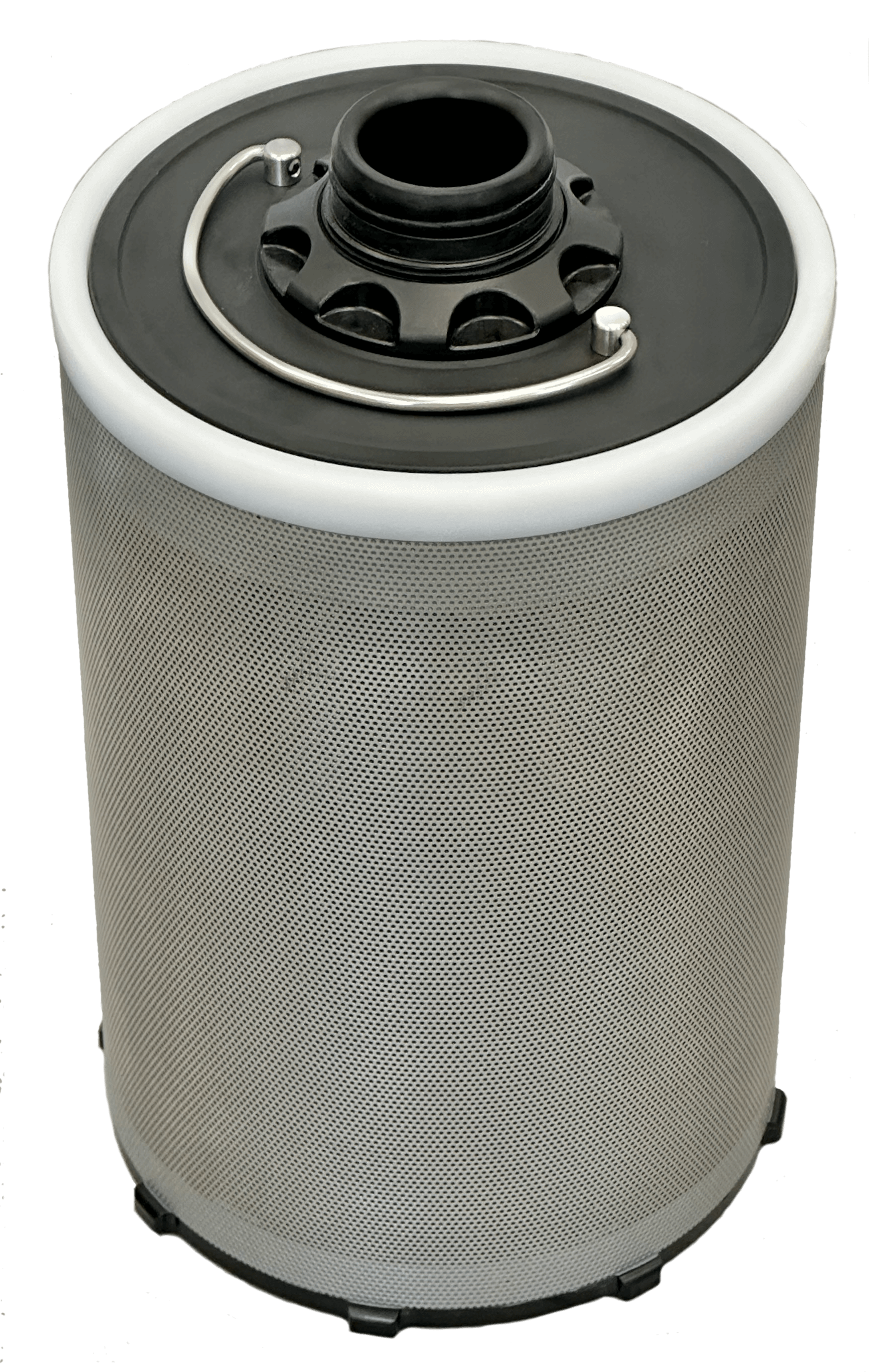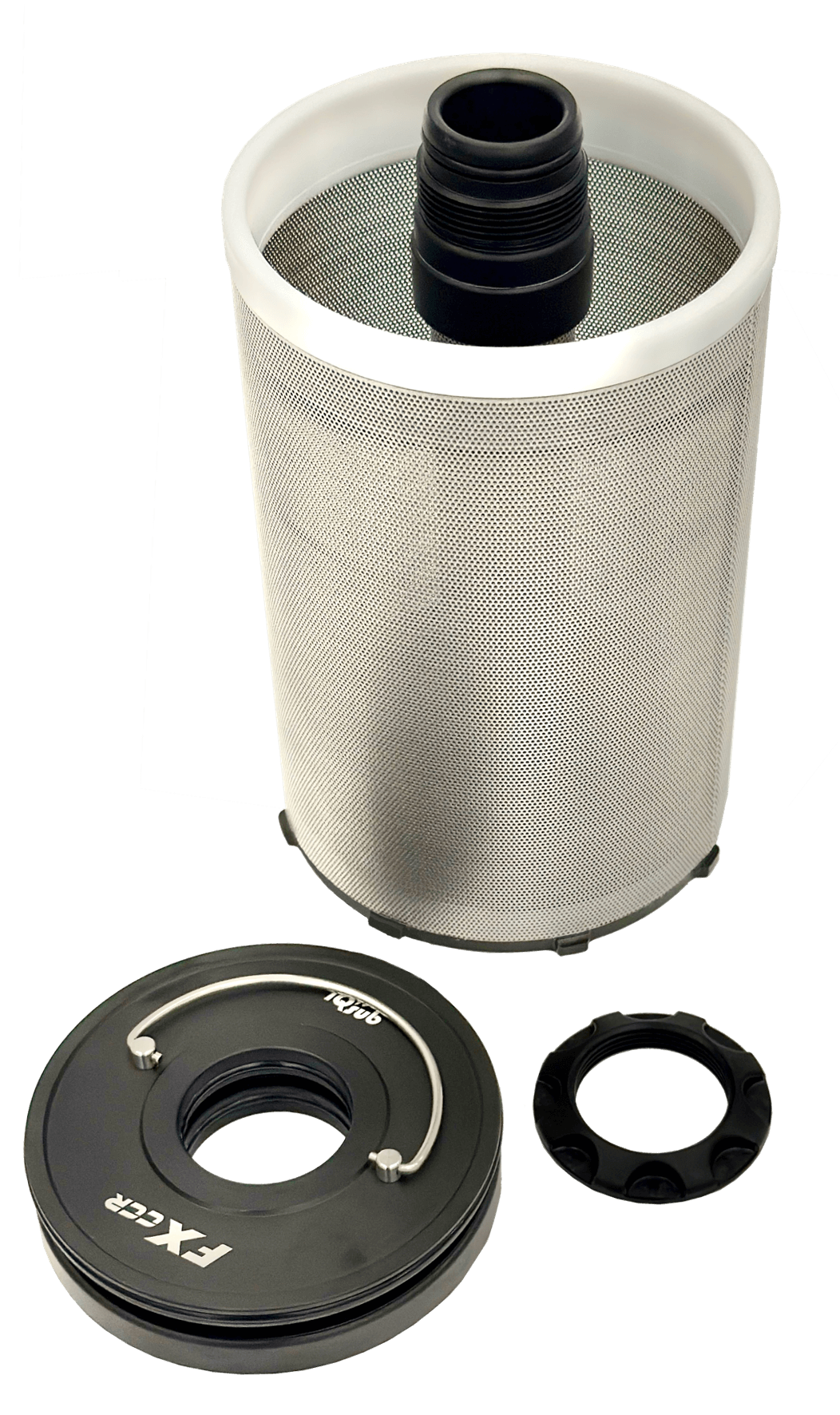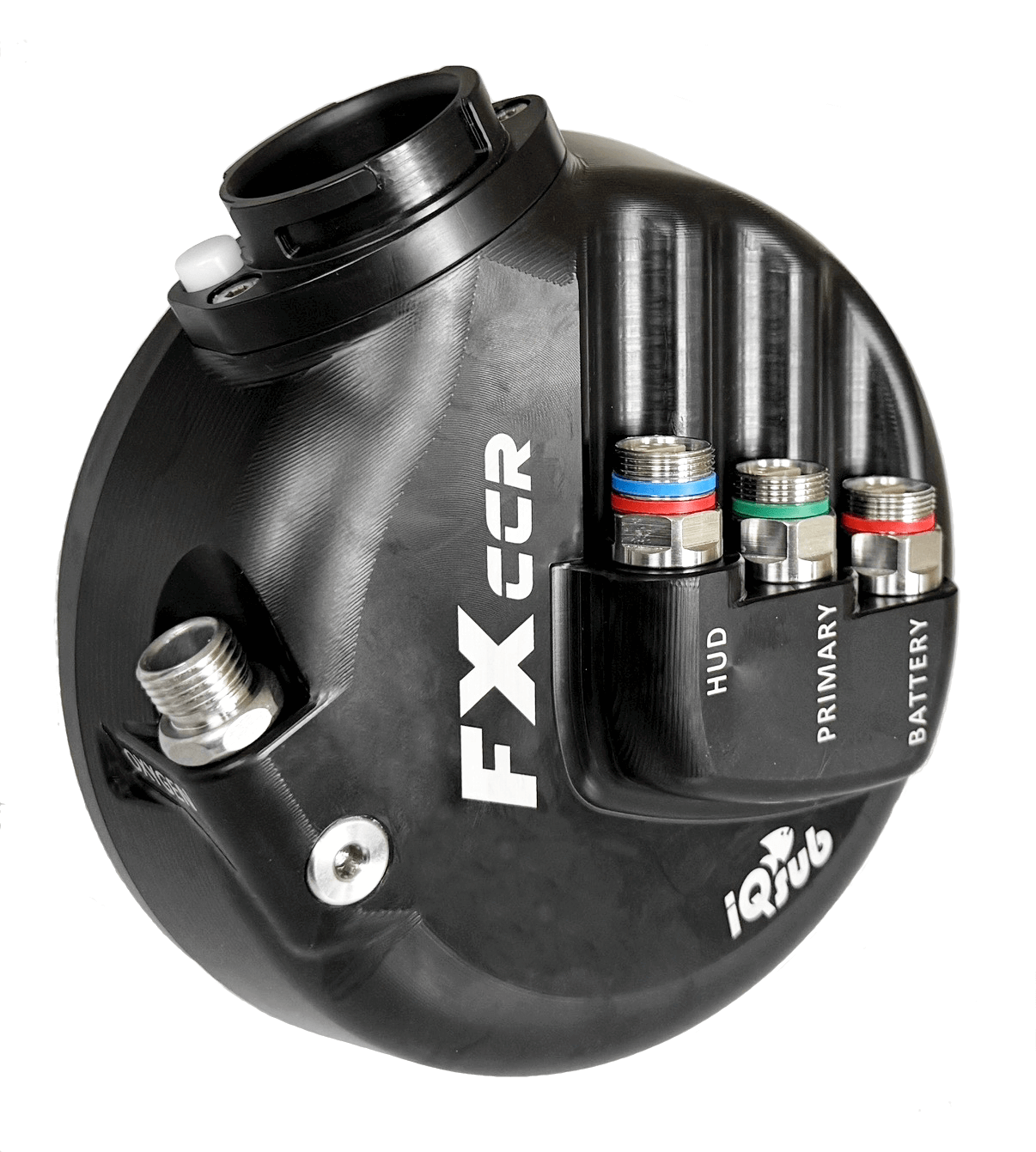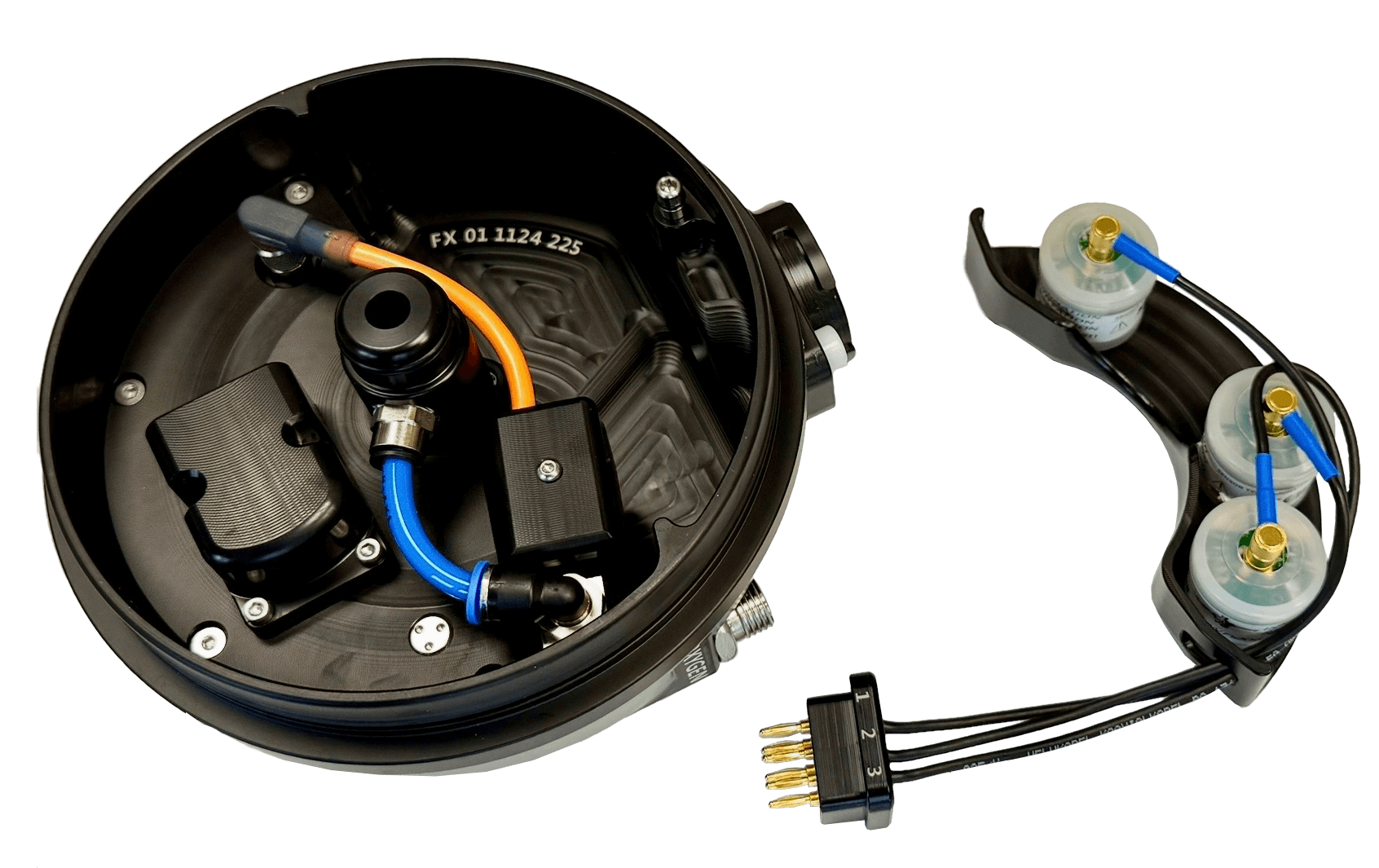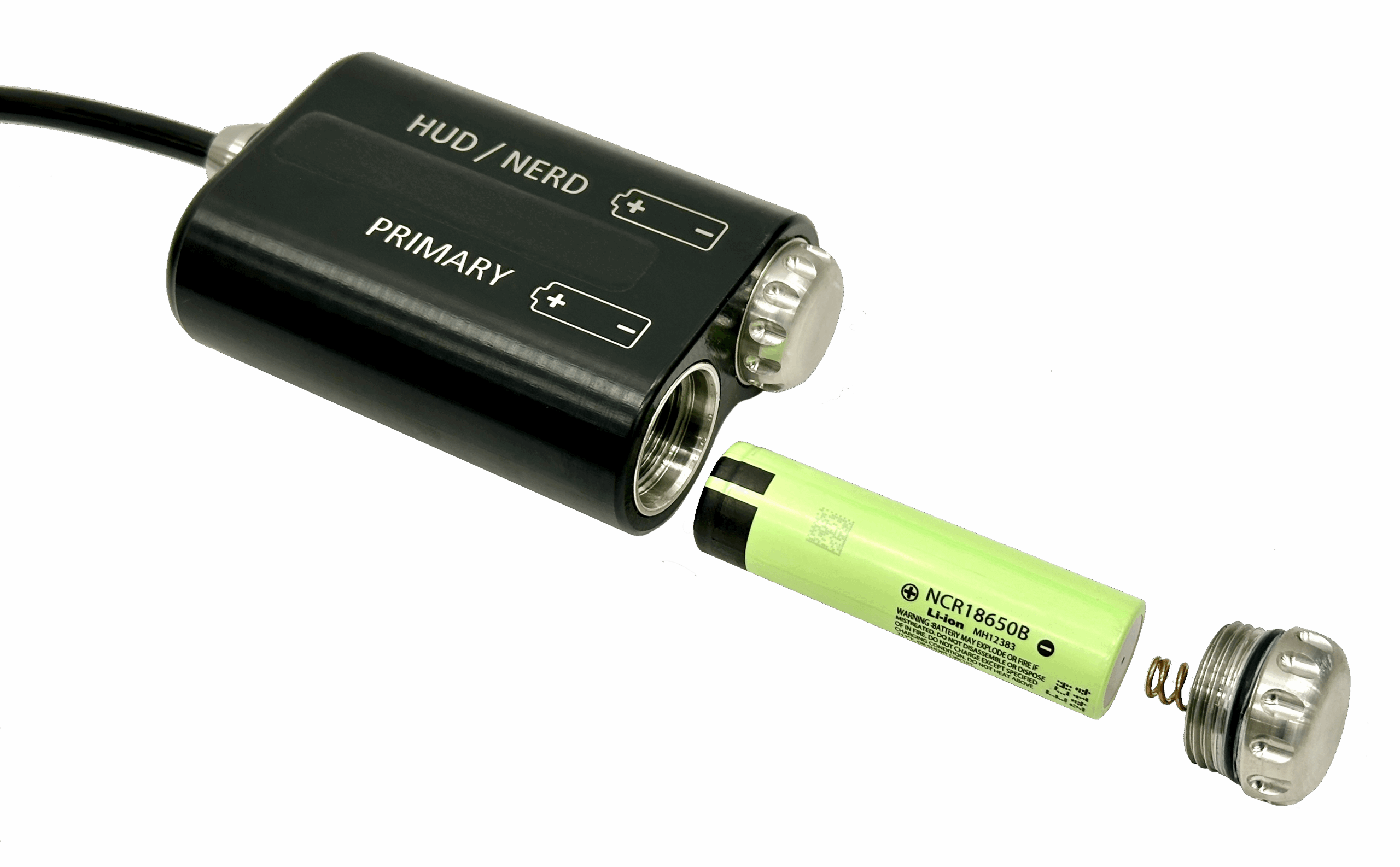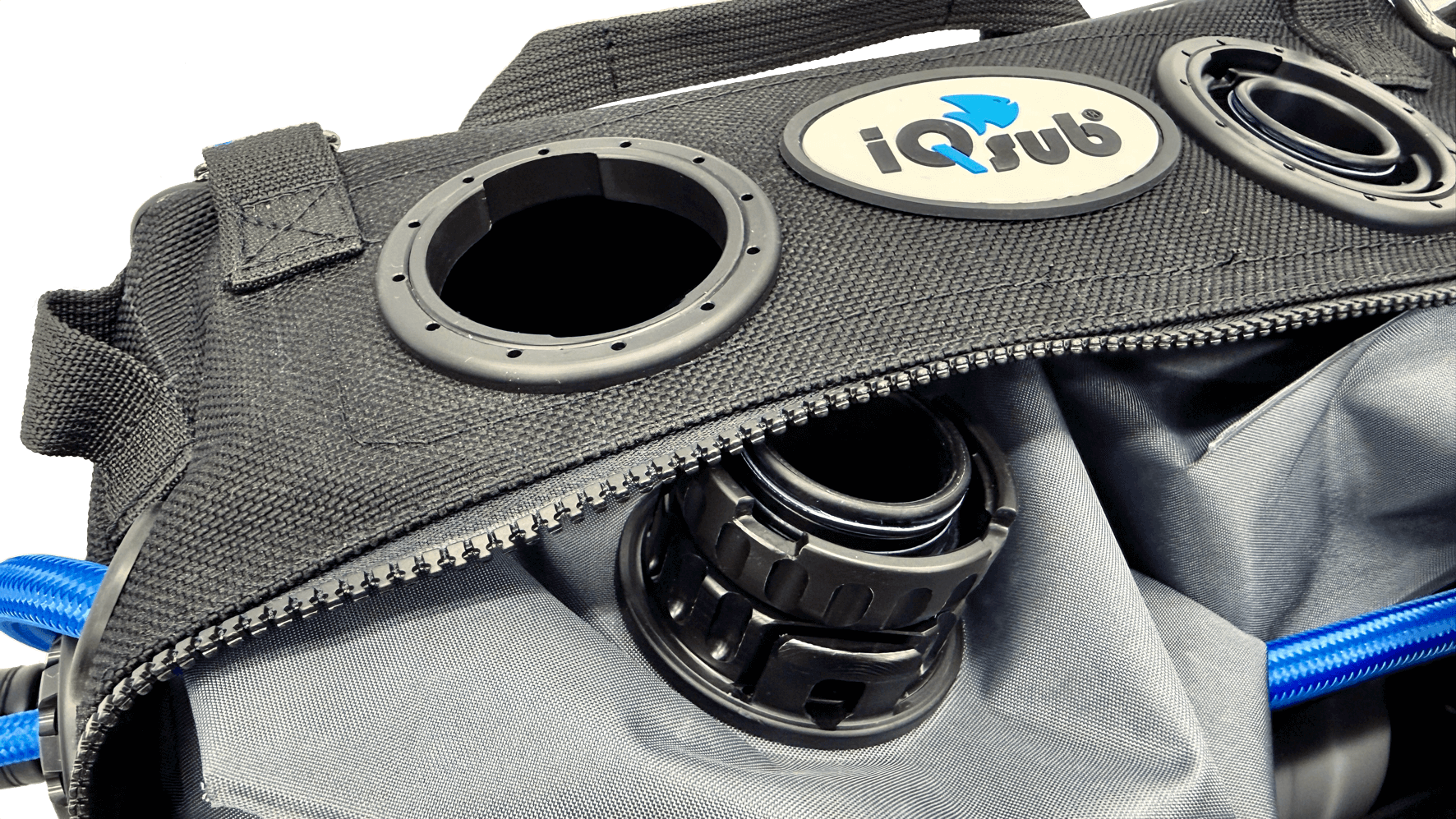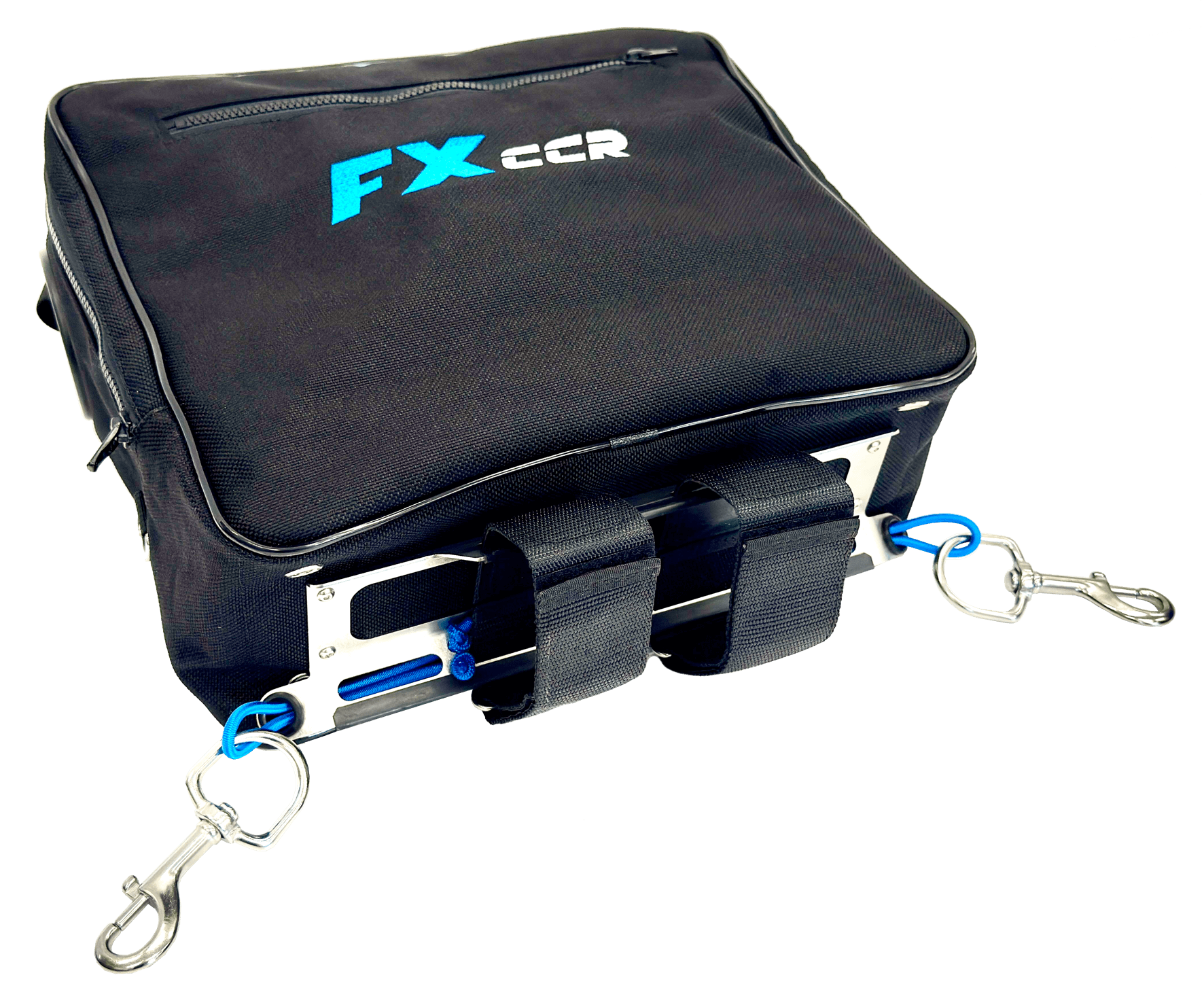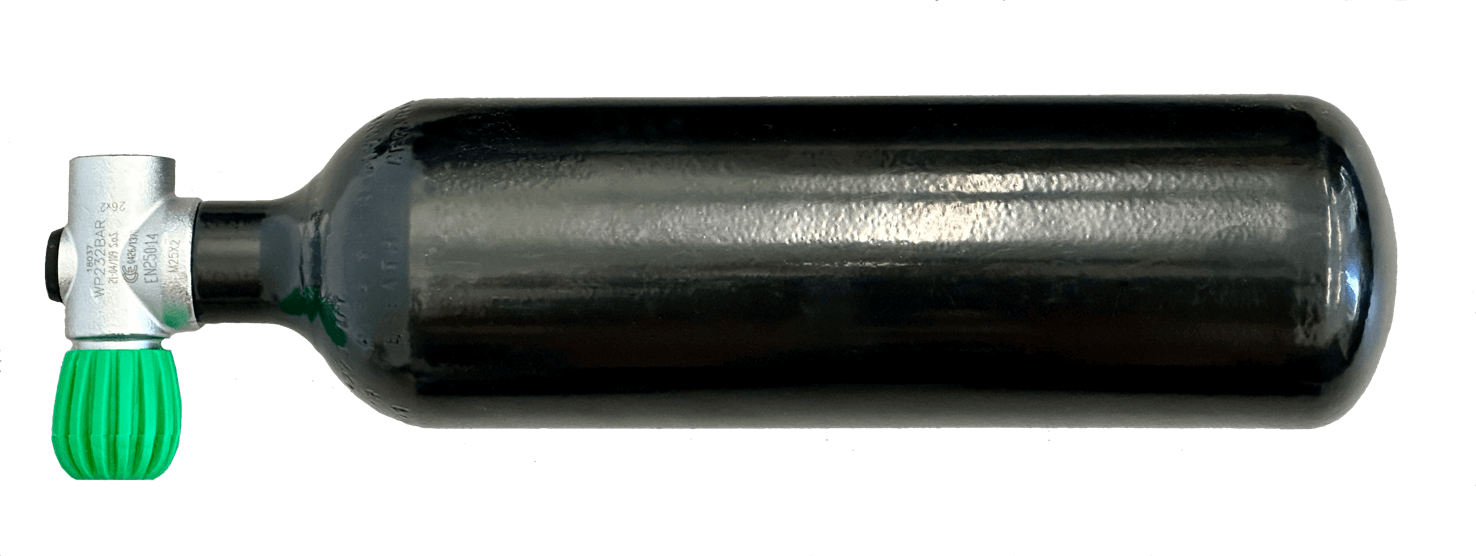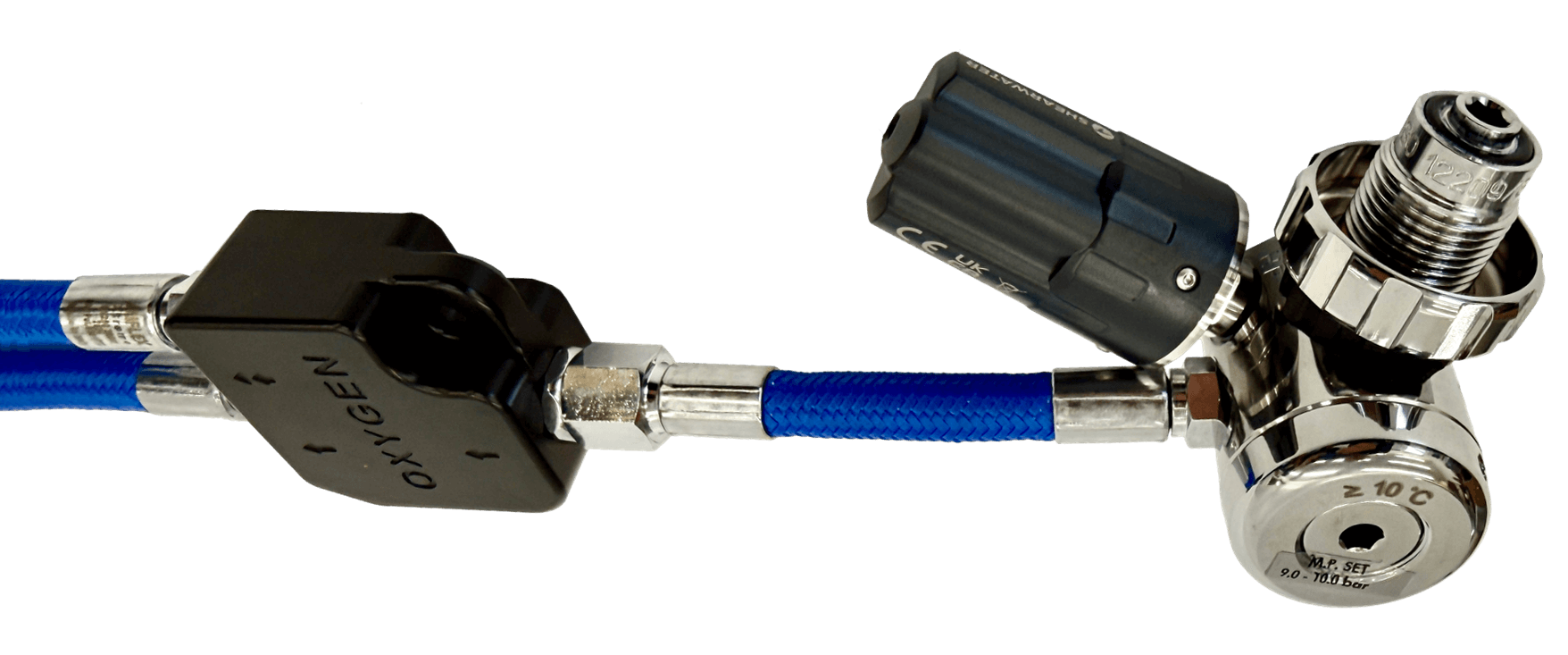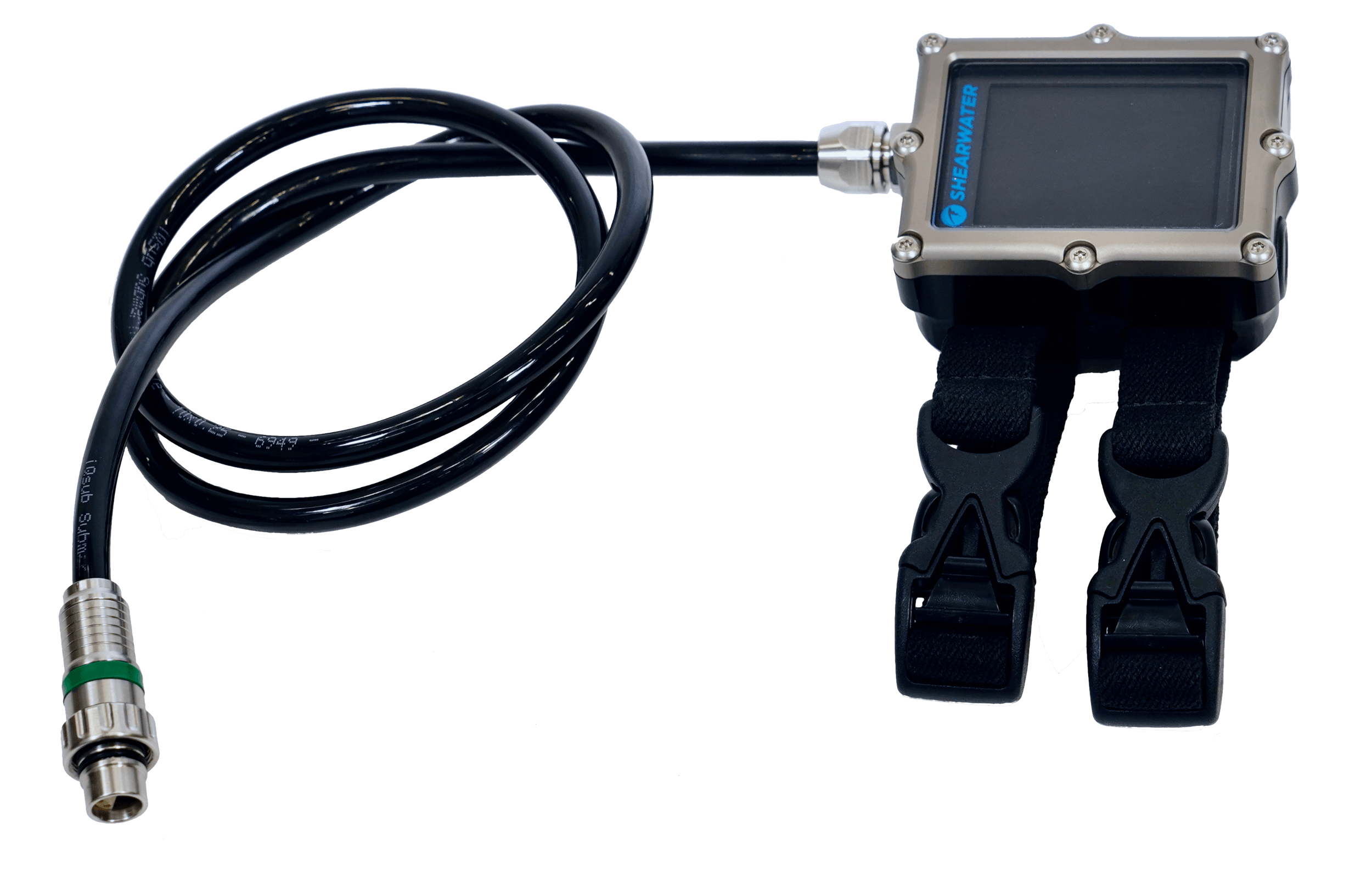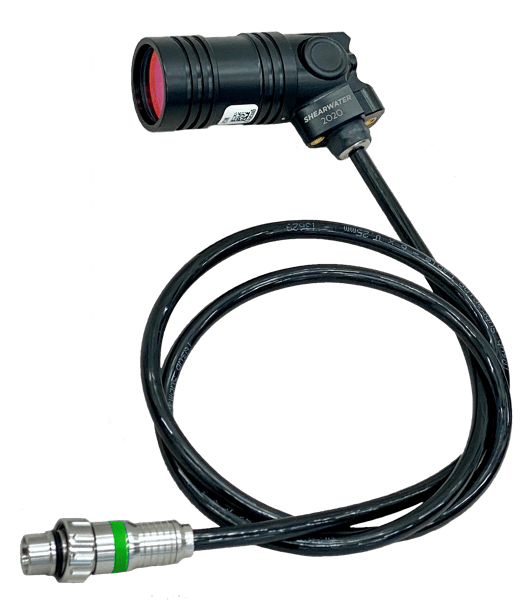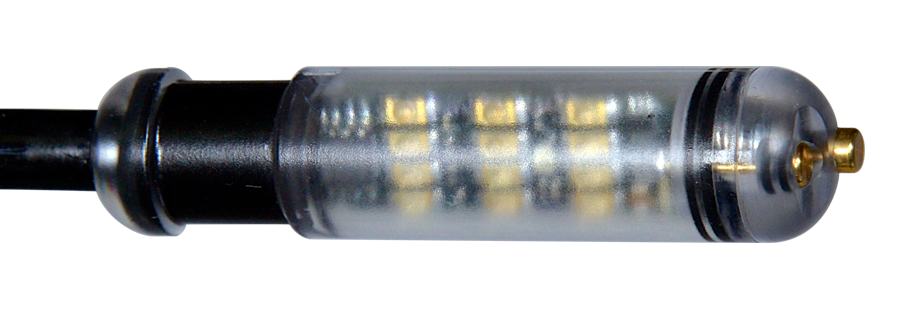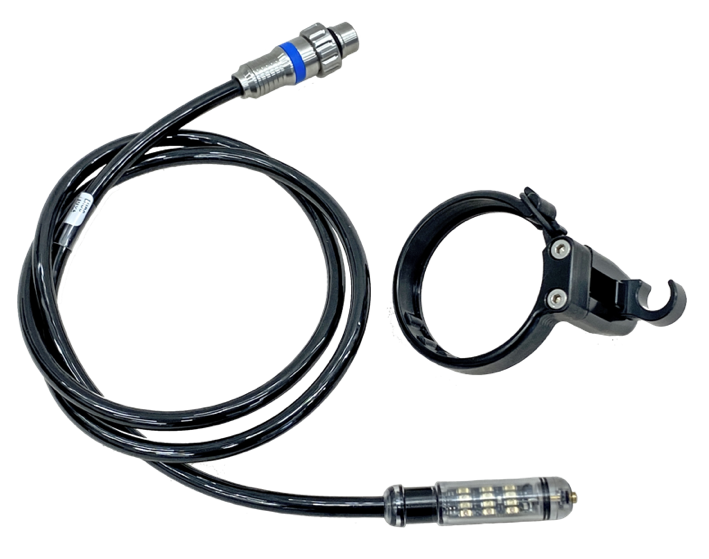FX CCR Body
FX Canister
The FX Canister is made of white Delrin.
It has a sealing O-ring and the inner locking groove at each its end for attaching and locking the FX Head
and Canister Lid.
The red mark on the canister indicates where the bayonet connector on the lid or head should be
positioned.
The FX Canister is placed horizontally in the case and secured with a Velcro strap to the canister holder at
the bottom of the case.
The Canister carries the Scrubber, the FX-head and the
Canister Lid.
The Canister Lid features a small built-in water trap that
prevents water from entering the scrubber.
The Head and Lid are secured in the Canister by the plastic string (2.4mm square profile) that is inserted
through the oval hole at the edge of the Canister (near the red mark).
Radial Scrubber
The FX CCR unit is standardly equipped with the radial scrubber placed in
the FX Canister.
The Radial Scrubber has capacity 2,3 kg of soda lime and the
operating time is up to 4 hours even in extreme conditions such as
cold water (4°C) and depths over 100m.
Scrubber consist of the outer and inner tubes made of very finely
perforated stainless steel sheet. The robust scrubber bottom holds the
both tubes together and is equipped with a folding handle for easy and
safe removal of the scrubber from the Canister. At the bottom of the
scrubber is a central hole with a short tube for injection and dispersion of
oxygen coming from the solenoid.
The scrubber is closed by the Scrubber Lid secured by a nut with
a robust thread.
The Scrubber lid is equipped with a spring loaded plate in order
to ensure self-packing feature – the spring loaded plate ensuring
sustained compression of the soda lime to protect against gas
channeling (bypassing the soda lime).
The Scrubber Lid has a folding handle for easy removal of the lid
from the scrubber.
When a scrubber is filled properly and the locking nut is
tightened by hand, the lid’s compressed plate sits flush with the
top ring of the scrubber.
FX Head & electronics
The CCR head is the heart of the FX-CCR,
containing the control electronics, solenoid
valve, removable Sensor holder with three
oxygen sensors, watertight connectors for
connecting the external controller, head-up
display and battery container.
The click-lock bayonet connector on the head
enables the inhalation counterlung to be
connected and disconnected easily and
quickly.
The FX head incorporates a solenoid with a
stainless steel outer body. The working
pressure of the solenoid is up to 17 bar.
The oxygen outlet from the solenoid is routed
through a blue PU tube to the centre plug and
then into the scrubber to pre-mix the oxygen
into the loop gas prior to measuring the ppO2
at the sensors.
The Control electronics (the Shearwater SOLO board) is built in the hermetic compartment inside the
head.
The SOLO board uses ppO2 readings from three O2 sensors to autonomously maintain the ppO2 in the
breathing loop according to the current selected setpoint.
Modular design compartmentalizes critical functions for redundancy. The Solenoid and Oxygen
electronics (on the SOLO board) can measure and inject oxygen independently of the Primary Controller
handset even in case that the handset or its cable is unplugged or damaged, while the SOLO board
continues to control loop PPO2 until the diver is surfacing.
The control electronics uses the DiveCAN®, a digital communication standard developed by Shearwater
Research Inc. specifically for rebreathers for robust error-checked communications.
PPO2 reading output from all three oxygen sensors are electronically separated one from another as well
as the PPO2 reading outputs to the Primary Controller Bus and the Secondary Monitoring Bus are
electronically separated one from another.
The Secondary Monitoring Bus is independent on the Primary Controller Bus and provides backup PPO2
monitoring in the event of a failure on the Primary Controller.
A fault or short circuit on any sensor does not affect the remaining ppO2 readings on the working device.
The Primary Controller, Head-Up Display (or NERD2) and
power supply Battery Container are connected via the
watertight connectors that are rated up to a depth of 300
metres.
The connectors allow flexible connection of the controller and
monitoring devices as well as easy disconnection for travel,
upgrades and repair.
The watertight connectors are color coded this way:
BLUE / RED – DiveCAN / Analog Monitoring Bus
GREEN – DiveCAN Controller Bus
RED – Power supply – the Battery Container
Three Oxygen sensors are placed in the easily removable
sensor holder.
The sensors are connected to the head electronics by cables with the rugged 6-pin connector with gold plated banana pins. The 6-pin
connector can be disconnected and reconnected at any time if
necessary.
The FX Solenoid valve has a Stainless steel AISI 316
body and operates up to 17 bar (above the ambient
pressure), therefore no pressure adjustment on the
1st stage regulator is needed.
The FX Solenoid is easily replaceable.
Battery Container
The FX unit is powered by batteries located in the Battery Container, which is connected to the FX-head
via a cable with the watertight connector.
The Battery container contains two independent, easily replaceable and rechargeable Li-Ion 18650
batteries that power the control electronics board, solenoid and Head-Up Display.
The Battery #1 supplies the Solenoid, the Battery #2 supplies the
Head-Up Display.
The batteries are easily accessible via the battery caps.
The correct battery polarity is displayed on the top of the container.
The Battery container is placed on top of the canister and secured
with a Velcro strap that holds the canister in place.
The container has two grooves on the bottom that fit over the
center collars of the FX canister.
Provide power supply of the control electronics board.
FX Case
The FX Case holds all parts together and allows the unit to be attached to the diver’s body.
The case is a soft bag made of Cordura 2000 and covers the FX Canister with FX-head, Battery Container
and Counterlungs.
The case carries on the outside the on-board oxygen cylinder 2L/300bar with 1st stage regulator,
breathing hoses and clamping carabiners.
The Case is equipped with
– 3 side zipper for access to the Canister and FX head
– Loops for attaching the LP hoses leading from
MAVs to L-pieces
– Soft handle for easy handling and carrying
– Round grommet on the right side for the
oxygen LP hose leading to the solenoid
– Oval grommet on left side for passing the cables
to the Handset and HUD
– Front zippered pocket for temporary storage of
the handset before/after a dive
– Small D-rings on sides for attaching MAVs or other
accessories
– Drain holes on the bottom and in the front pocket
for easy draining of water after a dive.
– Cylinder holder at the bottom with two Velcro straps
for attaching the on-board Oxy cylinder.
– 2 carabiners on the top and 2 carabiners at the
Cylinder holder to attach the unit to D-rings on
BCD straps.
Oxygen cylinder and 1st stage regulator
The unit is equipped with an on-board oxygen cylinder.
Carbon fiber cylinder 2L/300 bar ∅111mm or steel cylinder 2L/300bar ∅100mm is recommended.
The cylinder is attached to the Cylinder holder at the bottom of the Case and secured with two Velcro
straps.
The Apeks US4 1st stage regulator is connected to the oxygen cylinder valve.
Another 1st stage regulator, such as the Apeks DS4, can be used as long as it is oxygen-clean.
A 10cm LP hose is connected to the regulator outlet and leads to the Oxy MAV.
To measure the pressure in the oxygen cylinder, it is recommended to use the Shearwater SWIFT
transmitter connected to the 1st stage regulator with the pressure reading displayed on the Petrel
Controller.
As an alternative, a gauge that measures oxygen pressure can be connected to the 1st stage regulator via
an HP hose.
Primary Controller Handset
is the Shearwater DiveCAN Petrel 3 Controller, specifically designed for the XCCR, FLEX2 and FX.
The Primary Controller Handset is connected to the control electronics in the FX-head via a robust,
durable and very flexible cable with the X-connector, made of AISI 316 rated up to 300m depth and
marked with a GREEN ring.
Primary Controller Feature List
– Two PPO2 set-points, which can be set between 0.5 and 1.5
– Automatic PPO2 set-point switching (configurable)
– Depth, time, 3x ppO2 and deco data display
– Strong Vibration alert system
– Up to 4 pressure transmitters for gas pressure monitoring
– Bühlmann decompression model with gradient factors conservatism – Optional
VPM-B decompression model
– 5 CC and 5 OC gases
– Gases can be changed and added during a dive
– CNS tracking
– Any combination of oxygen, nitrogen, and helium (Air, Nitrox, Trimix) – Open and
closed circuit, switchable during a dive
– No lockout from violating deco stops
– Metric and Imperial units
– Automatic turn off on the surface (after 15 minutes)
– Tilt compensated digital compass
– Dive Planner
– 1000 hour dive log memory
– Log downloads and firmware upgrades using Bluetooth
– Flexible user replaceable “AA” battery of almost types
NERD 2 Controller
The FX CCR can optionally be fitted with the
Shearwater NERD 2 Controller, a compact, near-
eye Shearwater DiveCAN controller, instead of
the handset.
The NERD 2 Controller offers the same functions
and features as the Shearwater DiveCAN Petrel 3
controller.
Head-Up Display
The Head-Up Display (HUD) is compact Shearwater DiveCAN HUD with PPO2 monitoring on three O2
sensors.
The main feature of the Head-Up Display (the HUD) is to show the current status of ppO2 in the
breathing loop as well as ppO2 alarms to the diver.
The HUD has wet contacts for automatic turning on when submerged in water.
The HUD is power supplied by the battery #2 in the Battery Container.
The HUD is connected to the control electronics in the CCR head via a robust, durable and very flexible
cable with the X-connector, made of AISI 316 rated up to 300m depth and marked with a BLUE ring.
The HUD is placed in a two way adjustable holder located on the BOV Shrimp or DSV Shrimp.
NERD 2 Monitor
The FX CCR can optionally be fitted with a NERD 2 Monitor – the compact near to eye Shearwater
DiveCAN Computer in place of the HUD. The NERD 2 Monitor acts as a secondary computer with PPO2
monitoring on three O2 sensors and Trimix decompression.
NERD 2 Feature List
– Depth, time, 3x ppO2 and deco data display
– Bühlmann decompression model with gradient factors
conservatism – Optional VPM-B decompression model
– 5 CC and 5 OC gases
– Gases can be changed and added during a dive
– CNS tracking
– No lockout from violating deco stops
– Any combination of oxygen, nitrogen, and
helium (Air, Nitrox, Trimix) – Open and closed
circuit, switchable during a dive
– Metric and Imperial units
– Automatic turn off on the surface (after 15 minutes)
– Tilt compensated digital compass
– Dive Planner
– 1000 hour dive log memory
– Log downloads and firmware upgrades using Bluetooth.
The NERD 2 is power supplied by its own integrated rechargeable battery for up to 15 h operation time.
The NERD 2 has wet contacts for automatic turning on when submerged in water.
The NERD is connected to the CCR head control electronics via a robust, durable and very flexible cable
with the X-connector rated up to 300m depth and marked with a BLUE ring.
The NERD 2 is placed in a three way adjustable holder located on the BOV Shrimp.
Learn more about FX CCR:



